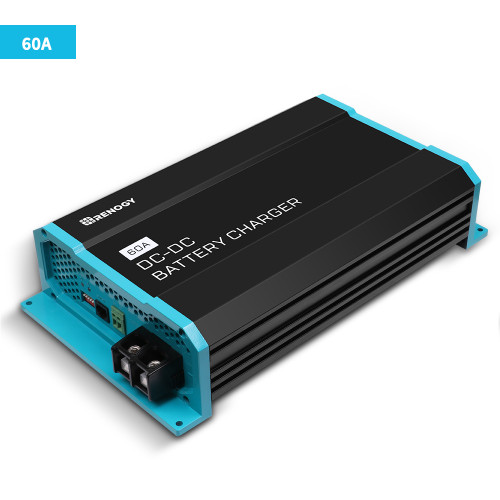







Compatible with both traditional and smart alternators, the DC-DC charger supports efficient generator starts while preventing over-discharge of the starter battery. (Recommended: 18–16 AWG copper cable; D+ ignition cable not included.)


The DC-DC battery charger’s LC wire adjusts charging current to prevent overcharging, protecting the house battery from damage. (Recommended: 18–16 AWG copper cable; LC cable not included.)






Package Includes
|
Renogy 60A DC to DC Battery Charger
1 x
|
System Voltage: 12VDC
Rated Charge Current: 60A
Output: 750W
Idle Power Consumption: <0.4 A
Input Voltage Range: 8V-16V
Equalization Voltage: N/A
Float Voltage: 13.2-13.8V
Boost Voltage: 14.1-14.7V
Operating Temperature: -20°C to +50°C
Weight: 5.3 lbs. / 2.4 kg
Dimensions: 12.2 x 6.9 x 2.7 in / 311 x 175 x 68 mm
Terminals: M8 X 10mm, 1mm thread pitch
Certification: CE/ROHS
opc:
Accessories: 1-year material warranty
opc:
FAQ
1. What is a DC-DC charger? What is its purpose?
2. How to choose a suitable battery charger?
1. Ensure the entire system operates at 12V.
2. Ensure that the maximum charging current provided by the DC-DC battery charger does not exceed the maximum charging current allowed by the house battery
3. How to set the charging voltage value of the charger?
4. What is the D+ Ignition cable? Is it necessary to connect?
The D+ Ignition cable is a design method used to identify whether the generator is started. This design method can well prevent the starting battery from being over-discharged during the charging process. When the generator is started, a signal will be obtained on the D+ Ignition cable, which will light up the indicator light of the charger.
The DC-DC will not power on or operate until the D+ ignition cable is connected.
5. How can I get these cables?
More questions about your off-grid power system? Learn more from Renogy Learning Center</a ></span ></strong >!</em >




































